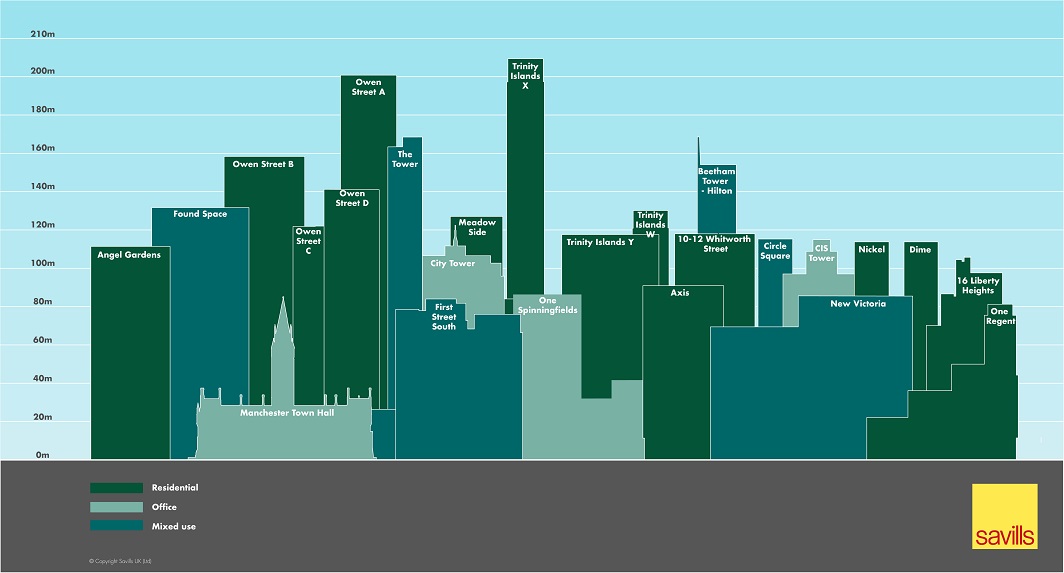This is Manchester… as you’ve never seen it before
Manchester’s ever-changing skyline is about to undergo further transformation. The construction of the towers at Owen Street and Trinity Islands will see the first skycrapers in the city, and the first in the UK outside London. The above composite graphic shows the dramatic impact the new tall buildings will have.
The below skyline diagram identifies buildings by predominant land-use, showing us that the recent rise of the city’s skyline is being driven by the residential sector. It’s a sign that the residential development market in Manchester is on the up. The demand for living in the city centre remains strong across all social groups, including retirement living.
The city’s history of tall buildings began more than 140 years ago in 1877 when the clock tower and spire of the Town Hall opened. It stands at around 85m and was the tallest structure in Manchester for a very long time.
The height of the spire was surpassed by the CIS Tower which was completed in 1962 and at the time was the tallest building in the UK standing at approximately 115m. Many of the existing towers in Manchester were developed during the 60s and 70s. Recognisable additions during this period include Portland Tower (1962, 80m), City Tower (1965, 123m) and Arndale House (1979, 90m). Of these only the City Tower building is shown on the skyline diagram, its silhouette distinctive for the antenna and radio transmitting equipment on its roof.
The iconic Beetham Tower Hilton Building, which opened in 2006 and stands at 169m, is currently the tallest tower in the city. This title went unchallenged as the economic recession of 2008 stifled development, particularly of this scale. The city’s appetite for tall buildings has evidently recovered. Recent additions to the skyline include One Spinningfields standing at around 86m and One Regent at 82m, both of which opened last year.
As the diagrams show, the rise of Manchester’s skyline continues, with many more additions planned or under construction.
In January this year the City Council’s Committee approved an update to the Great Jackson Street Strategic Regeneration Framework, where the Owen Street towers are currently being constructed. The Framework sets out proposals for a number of potential new towers which are set to transform the skyline at the southern end of the city centre.
The recently released Manchester Piccadilly Strategic Regeneration Framework also includes some plots which are considered appropriate for tall buildings above 20 stories high, which will create a sense of arrival for passengers arriving at the new HS2 terminal at Piccadilly Station, transforming the skyline at this important gateway to the eastern side of the city centre.
Selected industry experts bring you insight and expert advice, across a range of sectors.
Subscribe for free to receive our fortnightly round-up of property tips and expertise
Selected industry experts bring you insight and expert advice, across a range of sectors.
Subscribe for free to receive our fortnightly round-up of property tips and expertise





